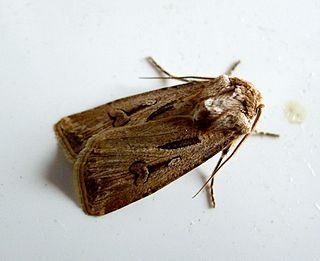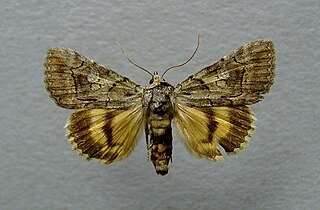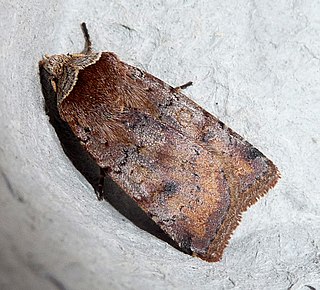
Agrotis segetum, sometimes known as the turnip moth, is a moth of the family Noctuidae. The species was first described by Michael Denis and Ignaz Schiffermüller in 1775. It is a common European species and it is found in Africa and across Eurasia except for the northernmost parts.

The heart and dart is a moth of the family Noctuidae. The species was first described by Carl Linnaeus in his 1758 10th edition of Systema Naturae. A familiar moth to many, it is considered one of the most common of the European region. It occurs throughout the Palearctic realm from Ireland to Japan.

Cutworms are moth larvae that hide under litter or soil during the day, coming out in the dark to feed on plants. A larva typically attacks the first part of the plant it encounters, namely the stem, often of a seedling, and consequently cuts it down; hence the name cutworm. Cutworms are not worms, biologically speaking, but caterpillars.

Ferdinand Ochsenheimer was a German actor and entomologist (lepidopterist).

Agrotis is a genus of moths of the family Noctuidae. The genus was erected by Ferdinand Ochsenheimer in 1816. A number of the species of this genus are extinct.

Agrotis puta, the shuttle-shaped dart, is a moth of the family Noctuidae. The species was first described by Jacob Hübner in 1803. It is common in the western part of Europe, but is also found in southern and central Europe, as well as North Africa and the Middle East.

Eucarta virgo, the silvery gem, is a moth of the family Noctuidae. The species first described by Georg Friedrich Treitschke in 1835. It can be found in south, southeast and central Europe.

Cryphia is a genus of moths of the family Noctuidae. The genus was erected by Jacob Hübner in 1818.

Omphalophana is a genus of moths of the family Noctuidae.

Agrotis fatidica is a moth of the family Noctuidae. It is found in Southern and Central Europe, east through Russia to Mongolia, China and Tibet.

Agrotis spinifera, or Gregson's dart, is a species of moth in the family Noctuidae. The species was first described by Jacob Hübner in 1808 and is found in southern Europe, Arabia to southern Africa, Madagascar, Turkey, Iraq, Iran, Afghanistan, Pakistan, India to Myanmar and Sri Lanka.

Catocala eutychea is a moth of the family Erebidae first described by Georg Friedrich Treitschke in 1835. It is found in the eastern parts of the Mediterranean, especially the Balkans.

Cerastis faceta is a moth of the family Noctuidae. It was described by Treitschke in 1835. It is found in Morocco, Algeria, Tunisia, Spain, Portugal, France, Italy, as well as on Corsica, Sardinia, Malta and Sicily.

Agrotis admirationis is a moth of the family Noctuidae. It is endemic to New Zealand. It was first described by Achille Guenée in 1868 from specimens collected by Richard William Fereday. Specimens of this species have been taken in Christchurch. Its favoured host plants are herbs found in open areas.













